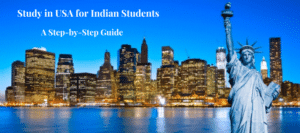Study in the USA for Indian Students Step-by-Step Guide

Why to Study in the USA?
Studying in the USA for Indian Students is a golden opportunity to get educated in the world’s number one study destination for higher education. It is home to the world’s most prestigious institutions and universities.
- Globally renowned education: American colleges such as Harvard, Stanford, and MIT are among the greatest in the world. American colleges provide a vast array of options for programs and courses, and their degrees are regarded and acknowledged throughout the world.
- Research opportunities: American institutions provide students with access to state-of-the-art facilities and resources. The country is a leader in innovation and research. Students can collaborate with internationally recognized academic members on innovative research projects.
- Diverse student body: Due to the United States’ status as a melting pot of cultures, students from all over the world are drawn to its colleges. This gives pupils the chance to interact with and learn from people from other backgrounds.
- Opportunities for post-study employment: International students studying in the United States may apply for Optional Practical Training (OPT), which enables them to work for up to a year in their field of study, once they have finished their studies. Students can connect with possible companies and acquire useful work experience in the US through this.
Top Courses to Study in the USA
| Course | Average Annual Tuition Fee (INR Lakhs) | Average Living Cost per Year (INR Lakhs) | Course Duration | Average Entry-Level Salary of Pass-outs (INR Lakhs p.a) |
| Computer Science | 20 – 40 | 10 – 15 | 2 – 3 years | 50 – 80 |
| Business Administration | 25 – 50 | 12 – 18 | 1.5 – 2 years | 60 – 90 |
| Electrical Engineering | 18 – 35 | 10 – 15 | 2 – 3 years | 55 – 75 |
| Data Science | 22 – 45 | 12 – 17 | 1.5 – 2 years | 55 – 85 |
| Mechanical Engineering | 15 – 30 | 10 – 14 | 2 – 3 years | 50 – 70 |
Scholarships Available to Indian Students in the USA
There are a number of scholarships available to Indian students who want to study in the USA. Names of some of the popular scholarships along with their website addresses are given below
- Fulbright-Nehru Master’s Fellowships-Website: Fulbright-Nehru Master’s Fellowships
- Tata Scholarships for Cornell University: Tata Scholarships for Cornell University
- Stanford Reliance Dhirubhai Fellowships-Website: Stanford Reliance Dhirubhai Fellowships
- Inlaks Scholarships-Website: Inlaks Scholarships
- World Bank / Joint Japan Graduate Scholarship Program-Website: Joint Japan/World Bank Graduate Scholarship Program
- Rotary International Ambassadorial Scholarships:Website: https://www.pfw.edu/dotAsset/eeaeb34f-0487-4999-9082-0c680d268ce6.pdf
- The Hubert H. Humphrey Fellowship Program-Website: https://www.humphreyfellowship.org/
- Fellowships for doctoral research funded by the USIEF-Website: USIEF Fulbright-Nehru Doctoral Research Fellowships
- AAUW International Fellowships-Website: AAUW International Fellowships
10. Dartmouth College Scholarships for Indian Students-Website: Dartmouth College Scholarships
- MIT Scholarships for Indian Students-Website: MIT Scholarships for International Students
Please refer to our blog https://eduler.in/scholarships-for-indian-students-in-the-usa/ to know more about the scholarship options available to Indian students in the USA.
Visa Requirements for the USA
Visa requirements for students wishing to pursue higher education in the United States
International students require an F-1 visa in order to study in the United States. The following are necessary for an F-1 visa:
- A current passport.
- A filled-out Form I-20.
- Proof of financial support.
- The results of an English language competency exam.
- A consultation with a US consular representative.
Form I 20
A Certificate of Eligibility for Nonimmigrant Student Status is what Form I-20 is. It is provided by the US college or institution where the applicant has been admitted. The student’s intended date of entry into the United States, their desired course of study, and their financial assistance are all detailed in the Form I-20.
Proof of Financial Support
To demonstrate that they have the resources to cover their living expenses as well as tuition and fees while studying in the United States, students must present proof of financial support. Bank statements, letters of scholarship acceptance, and sponsorship financial assistance letters are a few examples of this documentation.
English Language Proficiency Test Score
In order to receive an F-1 visa, students must prove their ability in the English language. Taking an English language proficiency exam, like the TOEFL or IELTS, is one way to accomplish this. Depending on the college or university the student has been accepted to, different minimum scores are needed.
Interview with a US Consular Officer
In addition, students have to successfully complete an interview at the US embassy or consulate in their nation of origin with a US consular officer. The student will be questioned by the consular officer regarding their plans for their studies, their source of funding, and their connections to their native nation.
Work Permit after Completion of the Course for Indian Students Studying in USA
Following their studies, Indian students studying in the United States may apply for a work permit. Students are permitted to work for up to a year in their field of study with this work permit, commonly known as Optional Practical Training (OPT). In order to remain in the United States and work for a maximum of three years following the completion of their education, students may also apply for a post-study work visa.
Availability of OPT
Students must meet the following requirements in order to be qualified for OPT:
- Be an F-1 student with a solid academic history.
- Have completed a minimum of one semester of rigorous courses.
- Submit an OPT application no later than ninety days after completing your coursework.
How to File an OPT Application
Students must send the following paperwork to US Citizenship and Immigration Services (USCIS) in order to apply for OPT:
- Application for Employment Authorization, Form I-765.
- Certificate of Eligibility for Nonimmigrant Student Status, Form I-20.
- A copy of the most current I-94 form you have.
- The processing charge.
Benefits of OPT
OPT provides Indian students with several advantages, such as: • The chance to establish contacts with possible employers; • The option to obtain useful work experience in the USA.
- The chance to receive compensation for work and assist with living expenses.
- The opportunity to sharpen your linguistic and cultural understanding in English.
Post-Study Work Visa
After completing their studies, Indian students majoring in STEM (science, technology, engineering, and mathematics) can apply for a post-study work visa, which enables them to remain in the country and work for a maximum of three years.
How to Apply for a Work Visa After Study
Students who wish to apply for a post-study employment visa must send the USCIS the following paperwork:
- Application for Employment Authorization, Form I-765.
- Certificate of Eligibility for Nonimmigrant Student Status, Form I-20.
- A processing fee
- A copy of your most current I-94 form.
A Post-Study Work Visa’s Advantages
For Indian students, there are several advantages to having a post-study work visa, such as:
- The possibility of building relationships with possible employers
- The chance to work in the USA and obtain useful work experience
- The chance to get paid and assist with living expenses
- The chance to advance your English language proficiency and cultural knowledge.
Is it necessary to get OPT first before getting Post Study Work Visa?
No, it is not necessary to get OPT first before applying for a post-study work visa in the USA. However, both options offer different benefits and timelines, so understanding the differences can help you decide which path might be best for your situation.
Optional Practical Training (OPT):
- Eligibility: Available to F-1 visa holders in valid status.
- Duration: Up to 12 months of full-time work authorization or 24 months for STEM graduates.
- Purpose: Gain practical experience related to your field of study.
- Benefits: Start working legally in the US after graduation, gain valuable experience for your resume, potentially network with potential employers.
- Drawbacks: Limited duration, job must be directly related to your field of study, processing time for the Employment Authorization Document (EAD) can be lengthy.
Post-study work visa:
- Eligibility: Available to certain F-1 visa holders after completing their studies and meeting specific program requirements.
- Duration: Varies depending on visa type (e.g., H-1B, O-1). Can be extended in most cases.
- Purpose: Long-term work authorization in the US, potentially leading to permanent residency.
- Benefits: Longer duration, greater flexibility in job choice, potential for permanent residency.
- Drawbacks: More competitive application process, stricter eligibility requirements, may require finding an employer to sponsor your visa.
Top Universities in the USA
Here is a list of some of the top US universities and the courses they offer:
- Harvard University-Computer Science, Engineering, Business Administration, Law, Medicine
- Stanford University Computer Science, Engineering, Business Administration, Medicine
- Massachusetts Institute of Technology (MIT)-Computer Science, Engineering, Business Administration, Science
- University of California, Berkeley-Computer Science, Engineering, Business Administration, Science, Liberal Arts
- University of Southern California-Computer Science, Engineering, Business Administration, Cinema, Fine Arts
- Princeton University-Computer Science, Engineering, Business Administration, Liberal Arts
- Columbia University- Computer Science, Engineering, Business Administration, Law, Medicine
- University of Chicago-Computer Science, Engineering, Business Administration, Law, Medicine
- Yale University -Computer Science, Engineering, Business Administration, Law, Medicine
- Cornell University-Computer Science, Engineering, Business Administration, Law, Medicine
- University of Pennsylvania-Computer Science, Engineering, Business Administration, Law, Medicine
Job Prospects in the US
International students might find several career chances in the US due to its robust economy. In the US, a few of the most sought-after positions are:
- Software engineers
- Data scientists
- Machine learning engineers
- Cloud engineers
- Product managers
- Financial analysts
- Business analysts
- Management consultants
- Physicians
Cost of Living in the USA for Indian Students
Although it varies by state and city, living expenses in the USA are often greater than those in India. The following is a summary of some of the main costs that Indian students studying in the United States should anticipate:
Accommodations
One of the largest costs for Indian students studying in the United States is housing. Although it’s frequently harder to find, on-campus accommodation is typically less expensive than off-campus housing. Although off-campus living can be more expensive, it provides more freedom with regard to facilities and location.
In the USA, the average annual cost of on-campus living is between $9,800 and $11,000. Monthly rent for off-campus accommodation is approximately $3,500 on average.
Food
The cost of food might also change based on the lifestyle and eating habits of the student. Students can reduce their food expenses by preparing their own meals at home. Students who frequently eat out or buy prepared meals will spend more money on food.
For Indian students studying in the United States, the average monthly food budget is between $400 and $606.
Transportation
The cost of transportation can also change based on the lifestyle of the student. It’s possible that students who live on campus or close to it don’t require a car. It may be necessary for students who reside off campus or who travel regularly to buy a car or take public transportation.
For Indian students studying in the United States, the typical monthly transportation budget is between $200 and $400.
Other expenses
Other expenses that Indian students may incur while studying in the USA include:
- Tuition fees
- Health insurance
- Textbooks and other academic supplies
- Entertainment and social activities
- Personal expenses
The average monthly budget for Indian students studying in the USA is around $1,500-$2,500.
Exams required to study in the USA
Tests of English proficiency for admission: TOEFL,PTE or IELTS
Which test should you choose?
The best test for you will depend on your individual needs and preferences. Here is a brief comparison of the three tests:
| Factor | TOEFL | PTE | IELTS |
| Length | 4 hours | 3 hours | 2 hours 45 minutes |
| Format | Paper-based or computer-based | Computer-based | Paper-based or computer-based |
| Scoring | Human-scored | Artificial intelligence-scored | Human-scored |
| Results | 10-16 days | 3-5 business days | 5-13 days |
| Acceptance | Worldwide | Worldwide | Worldwide |
Entrance exams for undergraduate degrees: SAT or ACT in USA
Which test should you choose?
The best test for you will depend on your individual strengths and weaknesses. Below is a comparison of the two tests:
| Factor | SAT | ACT |
| Length | 3 hours 45 minutes | 3 hours |
| Number of sections | 3 | 4 |
| Math section | Covers algebra, geometry, and trigonometry | Covers algebra, geometry, and trigonometry |
| Science section | None | Yes |
| Writing section | Yes | No |
| Scoring | 200-800 points per section; total score of 600-2400 points | 1-36 points per section; composite score of 1-36 points |
| Acceptance | Accepted by over 90% of four-year colleges in the USA | Accepted by all four-year colleges in the USA |
Entrance tests for postgraduate degrees including MA and MSc: GMAT or GRE
Which test should you choose?
The best test for you will depend on the type of postgraduate program you are applying to and on your individual strengths and weaknesses. Below is a comparison of the two tests:
| Factor | GMAT | GRE |
| Length | 3 hours 30 minutes | 3 hours 45 minutes |
| Number of sections | 4 | 3 |
| Subject Tests | Not required | Optional |
| Acceptance | Accepted by most business schools and many other graduate programs | Accepted by most graduate programs |
| Scoring | 200-800 points per section; total score of 600-2400 points | 130-170 points per section; total score of 260-340 points |
Entrance exams for MBA courses: GMAT
The Graduate Management Admission Test, or GMAT, is a standardized examination that is frequently used by US business schools to admit students to MBA programs. It has four pieces and lasts for three and a half hours:
Why is the GMAT important for MBA programs?
The GMAT is crucial for MBA programs since it helps in the evaluation of applicants’ verbal and quantitative thinking abilities by business schools. Since the goal of MBA programs is to train students for leadership positions in business, these abilities are critical to success.
Medicine degree entrance test: MCAT
Why is the MCAT important for medical school applicants?
All US medical schools require the completion of the standardized MCAT (Medical College Admission Test) in order to provide admission. This test has four components and lasts for seven and a half hours:
- Foundations of Chemistry and Physics for Biological Systems: This portion evaluates your understanding of biochemistry, physics, and chemistry.
- Critical Analysis and Reasoning Skills: Your ability to think critically and solve problems is evaluated in this area.
- Foundations of Biology and Biochemistry of Living Systems: This portion evaluates your understanding of genetics, biology, and biochemistry.
- Biology, Social, and Psychological Foundations of Conduct: You will be evaluated on your understanding of the biological, sociological, and psychological underpinnings of conduct in this part.
The MCAT is important for medical school applicants because it helps medical schools assess the scientific knowledge and problem-solving skills of their applicants. These skills are essential for success in medical school, which is a rigorous and demanding program.
Law degree admission test: LSAT
The LSAT (Law School Admission Test) is a standardized test that is required for admission to all law schools in the USA. It is a three-hour and 30-minute test with five sections:
- Logical Reasoning: This section assesses your ability to analyze and reason logically.
- Analytical Reasoning: This section assesses your ability to understand and analyze complex legal arguments.
- Reading Comprehension: This section assesses your ability to read and understand complex legal passages.
- Writing: This section assesses your ability to write clear and concise legal arguments.
- Unscored Experimental Section: This section is not scored, but it is used by the LSAT to test new questions.
Why is the LSAT important for law school applicants?
The LSAT is important for law school applicants because it helps law schools assess the critical thinking, analytical reasoning, and reading comprehension skills of their applicants. These skills are essential for success in law school, which is a rigorous and demanding program.
Given below is a List of exams required to study in the USA with the fee details in the form of a table:
| Exam | Fee (INR) | Duration |
| TOEFL | ₹17,400 | 3 hrs |
| PTE | ₹19,300 | 2hrs 15 min |
| IELTS | ₹ 16,500 | 2hrs 45 min |
| SAT | ₹4,900 | 3hrs 45 min |
| ACT | ₹4,200 | 3.5hrs |
| GMAT | ₹21,000 | 3hrs |
| GRE | ₹16,000 | 3hrs 45 min |
| MCAT | ₹24,900 | 7.5hrs |
| LSAT | ₹15,400 | 3.5hrs |
Read more such interesting articles on Study Abroad by visiting our Facebook Page




